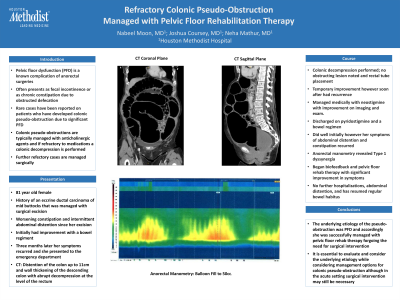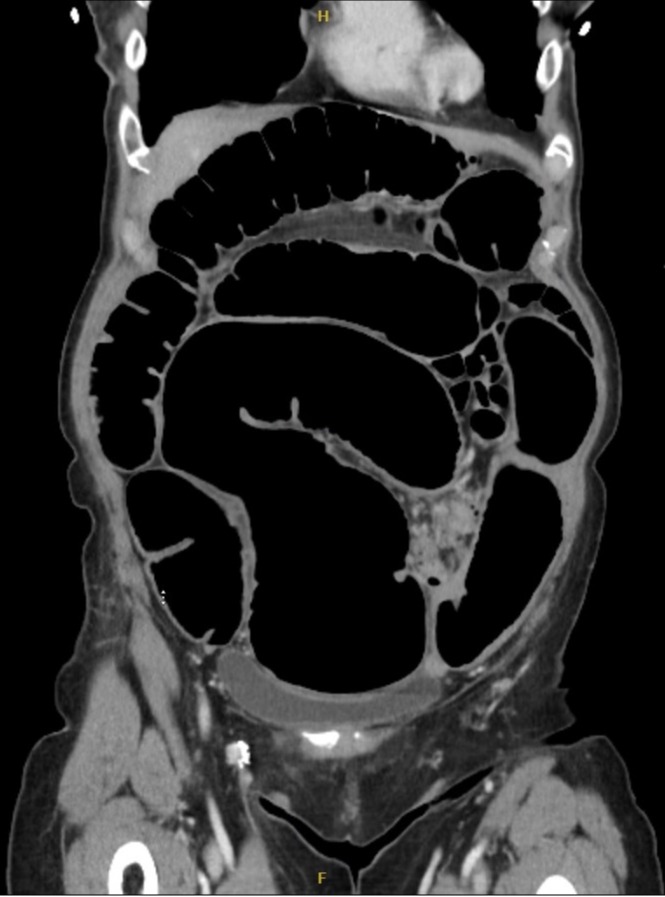Sunday Poster Session
Category: Colon
P0271 - Refractory Colonic Pseudo-Obstruction Managed With Pelvic Floor Rehabilitation Therapy
Sunday, October 22, 2023
3:30 PM - 7:00 PM PT
Location: Exhibit Hall

Has Audio

Nabeel Moon, MD
Houston Methodist Hospital
Houston, TX
Presenting Author(s)
Nabeel Moon, MD, Joshua Coursey, MD, Neha Mathur, MD
Houston Methodist Hospital, Houston, TX
Introduction: Pelvic floor dysfunction is a known complication of anorectal surgeries. Pelvic floor dysfunction often presents itself as fecal incontinence or as chronic constipation due to obstructed defecation. Rare cases have been reported on patients who have developed colonic pseudo-obstruction due to significant pelvic floor dyssynergia. We are reporting a case of a patient who underwent an anorectal surgery with subsequent development of a colonic pseudo-obstruction secondary to pelvic floor dyssynergia. She was refractory to medical and endoscopic management however showed complete resolution of her symptoms with pelvic floor rehabilitation therapy.
Case Description/Methods: An 81 year old female was diagnosed with an eccrine ductal carcinoma of mid buttocks and underwent surgical excision. Since her excision she reported worsening constipation and intermittent abdominal distention. She initially showed improvement with a bowel regiment. Three months after her initial presentation her symptoms recurred and she presented to the emergency department. CT scan revealed colonic distention up to 11cm and wall thickening of the descending colon with abrupt decompression at the level of the rectum. A colonic decompression was performed with no obstructing lesion noted and a rectal tube was placed. She had improvement in her distention however soon after had recurrence. She was then managed medically with neostigmine with overall improvement. She was discharged on pyridostigmine for pro-motility effects. She did well initially however her symptoms recurred. She was then evaluated with anorectal manometry which revealed Type 1 dyssynergia and began pelvic floor rehab therapy. After a few sessions she began having significant improvement in her symptoms. Since starting therapy she has had no further hospitalizations, abdominal distention, and has resumed regular bowel habitus.
Discussion: Colonic pseudo-obstructions are typically managed with anticholinergic agents and if refractory to medications a colonic decompression is performed. Further refectory cases are managed surgically. In our case the underlying etiology of the pseudo-obstruction was pelvic floor dyssynergia and accordingly was successfully managed with pelvic floor rehab therapy forgoing the need for surgical intervention. As shown by our case it is essential to evaluate and consider the underlying etiology while considering management options for colonic pseudo-obstruction although in the acute setting surgical intervention may still be necessary.

Disclosures:
Nabeel Moon, MD, Joshua Coursey, MD, Neha Mathur, MD. P0271 - Refractory Colonic Pseudo-Obstruction Managed With Pelvic Floor Rehabilitation Therapy, ACG 2023 Annual Scientific Meeting Abstracts. Vancouver, BC, Canada: American College of Gastroenterology.
Houston Methodist Hospital, Houston, TX
Introduction: Pelvic floor dysfunction is a known complication of anorectal surgeries. Pelvic floor dysfunction often presents itself as fecal incontinence or as chronic constipation due to obstructed defecation. Rare cases have been reported on patients who have developed colonic pseudo-obstruction due to significant pelvic floor dyssynergia. We are reporting a case of a patient who underwent an anorectal surgery with subsequent development of a colonic pseudo-obstruction secondary to pelvic floor dyssynergia. She was refractory to medical and endoscopic management however showed complete resolution of her symptoms with pelvic floor rehabilitation therapy.
Case Description/Methods: An 81 year old female was diagnosed with an eccrine ductal carcinoma of mid buttocks and underwent surgical excision. Since her excision she reported worsening constipation and intermittent abdominal distention. She initially showed improvement with a bowel regiment. Three months after her initial presentation her symptoms recurred and she presented to the emergency department. CT scan revealed colonic distention up to 11cm and wall thickening of the descending colon with abrupt decompression at the level of the rectum. A colonic decompression was performed with no obstructing lesion noted and a rectal tube was placed. She had improvement in her distention however soon after had recurrence. She was then managed medically with neostigmine with overall improvement. She was discharged on pyridostigmine for pro-motility effects. She did well initially however her symptoms recurred. She was then evaluated with anorectal manometry which revealed Type 1 dyssynergia and began pelvic floor rehab therapy. After a few sessions she began having significant improvement in her symptoms. Since starting therapy she has had no further hospitalizations, abdominal distention, and has resumed regular bowel habitus.
Discussion: Colonic pseudo-obstructions are typically managed with anticholinergic agents and if refractory to medications a colonic decompression is performed. Further refectory cases are managed surgically. In our case the underlying etiology of the pseudo-obstruction was pelvic floor dyssynergia and accordingly was successfully managed with pelvic floor rehab therapy forgoing the need for surgical intervention. As shown by our case it is essential to evaluate and consider the underlying etiology while considering management options for colonic pseudo-obstruction although in the acute setting surgical intervention may still be necessary.

Figure: CT revealing colonic distention up to 11 cm
Disclosures:
Nabeel Moon indicated no relevant financial relationships.
Joshua Coursey indicated no relevant financial relationships.
Neha Mathur indicated no relevant financial relationships.
Nabeel Moon, MD, Joshua Coursey, MD, Neha Mathur, MD. P0271 - Refractory Colonic Pseudo-Obstruction Managed With Pelvic Floor Rehabilitation Therapy, ACG 2023 Annual Scientific Meeting Abstracts. Vancouver, BC, Canada: American College of Gastroenterology.
